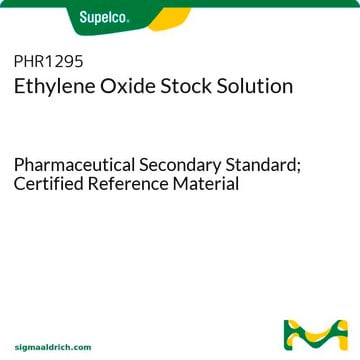743593
Ethylenoxid
≥99.9%
Synonym(e):
Oxiran
About This Item
Empfohlene Produkte
Assay
≥99.9%
Form
gas
Brechungsindex
n20/D 1.3597 (lit.)
bp
10.7 °C (lit.)
mp (Schmelzpunkt)
−111 °C (lit.)
Dichte
0.882 g/mL at 25 °C (lit.)
Lagertemp.
2-8°C
SMILES String
C1CO1
InChI
1S/C2H4O/c1-2-3-1/h1-2H2
InChIKey
IAYPIBMASNFSPL-UHFFFAOYSA-N
Suchen Sie nach ähnlichen Produkten? Aufrufen Leitfaden zum Produktvergleich
Verpackung
Sonstige Hinweise
Empfohlene Produkte
Ähnliches Produkt
Signalwort
Danger
Gefahreneinstufungen
Acute Tox. 3 Inhalation - Acute Tox. 3 Oral - Carc. 1B - Chem. Unst. Gas A - Eye Dam. 1 - Flam. Gas 1A - Muta. 1B - Press. Gas Liquefied gas - Repr. 1B - Skin Corr. 1B - STOT RE 1 - STOT SE 3
Zielorgane
Central nervous system, Nervous system, Respiratory system
Lagerklassenschlüssel
2A - Gases
WGK
WGK 3
Flammpunkt (°F)
-4.0 °F - closed cup
Flammpunkt (°C)
-20.0 °C - closed cup
Analysenzertifikate (COA)
Suchen Sie nach Analysenzertifikate (COA), indem Sie die Lot-/Chargennummer des Produkts eingeben. Lot- und Chargennummern sind auf dem Produktetikett hinter den Wörtern ‘Lot’ oder ‘Batch’ (Lot oder Charge) zu finden.
Besitzen Sie dieses Produkt bereits?
In der Dokumentenbibliothek finden Sie die Dokumentation zu den Produkten, die Sie kürzlich erworben haben.
Kunden haben sich ebenfalls angesehen
Unser Team von Wissenschaftlern verfügt über Erfahrung in allen Forschungsbereichen einschließlich Life Science, Materialwissenschaften, chemischer Synthese, Chromatographie, Analytik und vielen mehr..
Setzen Sie sich mit dem technischen Dienst in Verbindung.










